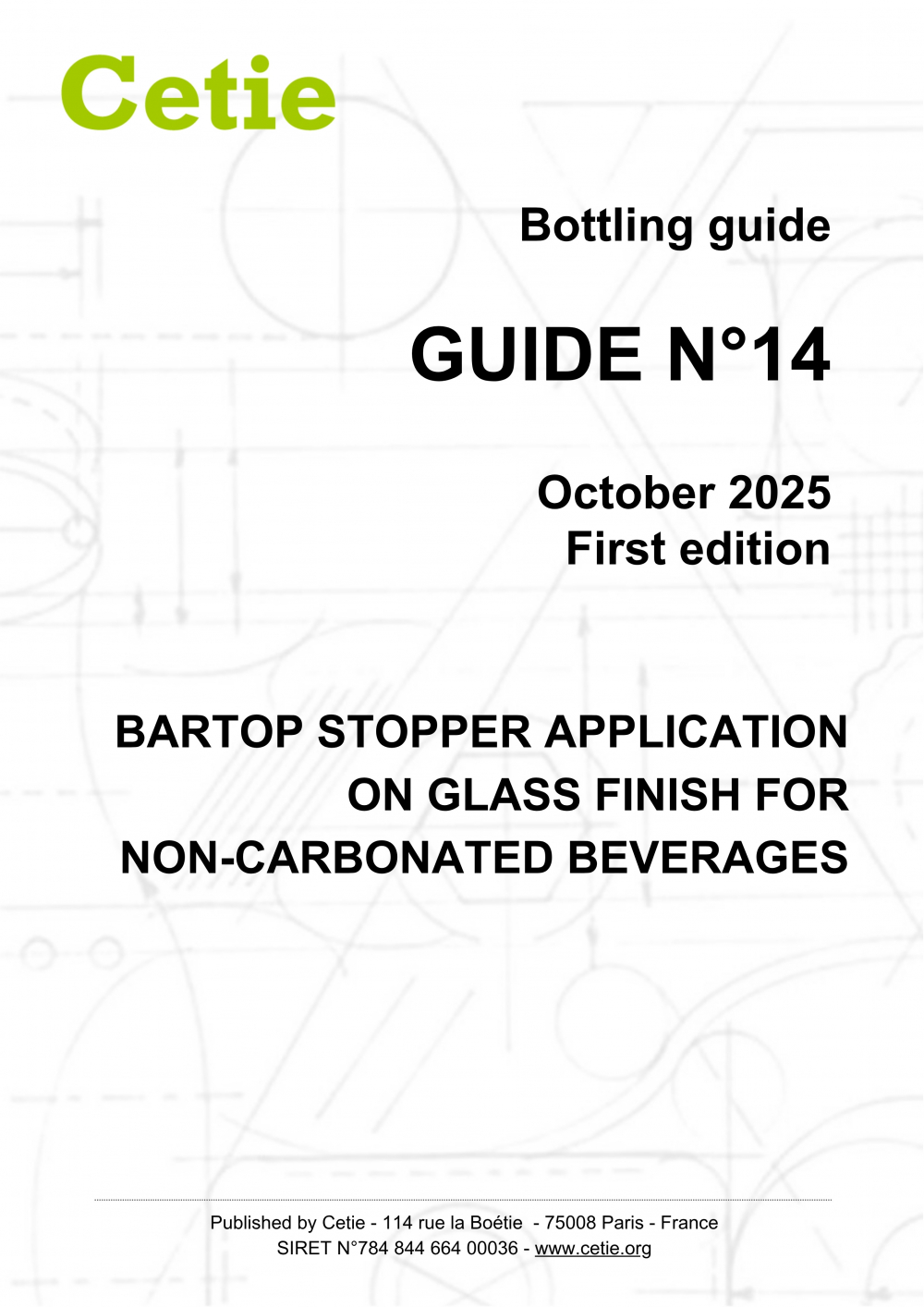Guide No.14
First edition
Published on: 22/10/2025
Bartop stopper application on glass finish for non-carbonated beverages
Scope of application
This guide describes the good practices to apply to obtain quality application with bartop stoppers which enable the consumer to open and reclose a bottle by hand without requiring a tool. These practices will only be used with glass bottles with stoppers whose sealing results from the contact between the body of the stopper and the internal surface of the neck of the bottle. The application can be supplemented by an overcap and/or a sleeve. This guide only concerns non-carbonated beverages, it does not concern water, oil, or vinegar. It is designed for all professionals (suppliers, third-party service providers and users).
This guide applies only to bartop stoppers with bodies made of cork according to the standard ISO 633 - CORK - VOCABULARY.
This guide applies only to bartop stoppers with bodies made of cork according to the standard ISO 633 - CORK - VOCABULARY.
Table of contents
1. Scope of the guide
2. Definitions
2.1. Bartop stopper
2.2. Still alcoholic drink
2.3. Overcap
2.4. Wax
2.5. Sleeve
2.6. Tamper-evident neck band
3. General requirements
3.1. Public health safety
3.2. Traceability of supplies
3.3. General principles of statistical control
3.4. Recommendations for storage
3.4.1. Storage facilities
3.4.2. Environmental conditions
3.4.3. Personnel and equipment
3.4.4. Shelf life and integrity of the original packaging of the supplies
3.4.5. Transport recommendation
4. Bartop closure system supplies
4.1. Bottle
4.1.1. Terminology – Functions
4.1.2. Bottle neck finish
4.1.3. Constituent materials
4.1.4. Dimensional characteristics
4.1.5. Checking
4.1.6. Packaging – Identification
4.1.7. Storage particular conditions
4.2. Bartop stopper
4.2.1. Functions of the bartop closure
4.2.2. Constituent materials
4.2.3. Dimensional characteristics
4.2.4. Checking
4.2.5. Packaging – Identification
4.2.6. Storage particularities
4.3. Overcap
4.3.1. Functions
4.3.2. The different types of overcaps
4.3.3. Visual inspection of the caps prior to production
4.3.4. Constituent materials
4.3.5. Dimensional characteristics
4.3.6. Checking during overcap production
4.3.7. Packaging – Identification
4.3.8. Storage particularities
5. Materials and conditions of application
5.1. Preliminary operations
5.1.1. Fill levels and headspace
5.2. Settings and controls of the equipment
5.2.1. Multi-head rotating machines
5.2.2. Feeding the centring devices
5.2.3. Setting of the star wheel on the pick and place plate
5.2.4. Regulation of the cork distribution star wheel
5.2.5. Single-head machine
5.2.6. Corking defects
5.3. Closure
5.4 Fitting the overcap
6. Identifying and resolving defects/troubleshooting
6.1. Defect classification
6.2. Troubleshooting
7. Related documents
7.1. Standards
7.2. Cetie
7.3. Others
8. Document history
History
First editon: 10/2025
First editon: 10/2025
Contributors
AMCOR FLEXIBLES CAPSULES, AMCOR RIGID PACKAGING PLC, AMORIM FRANCE, ANFEVI (Asociacion Nacional de Fabricantes de Envases de Vidrio), ARDAGH GLASS GmbH, ARDAGH GLASS PACKAGING S.A PROPERTY LIMITED, ARDAGH GROUP S.A. POLAND, AROL S.p.A., BA GLASS PORTUGAL, BACARDI & COMPANY LTD, BACARDI MARTINI FRANCE, BERLIN PACKAGING FRANCE, BERLIN PACKAGING LLC, BERTOLASO S.p.A, BOUCHAGES DELAGE, BRITISH GLASS (British Glass Manufacturers Federation, BUNDESVERBAND GLASINDUSTRIE E.V. (Federal Association of the German Glass Industry), CAN PACK, CONCHA Y TORO, CONFÉDÉRATION EUROPÉENNE DU LIÈGE, CORK SUPPLY PORTUGAL, DIAM BOUCHAGE, E. REMY MARTIN & Co., ENCIRC GLASS, EPG Service GmbH, ETS ANDRE ZALKIN & CIE), FEDERATION FRANCAISE DU LIEGE, GEORGES MONIN, GERRESHEIMER BELGIUM, GERRESHEIMER TETTAU, GROUPE CASTEL, GROUPE ICV - CENTRE OENOLOGIQUE DE MAURIN, GUALA CLOSURES S.P.A., KRONES AG, MOET & CHANDON, MOET & HENNESSY, O-I MANUFACTURING DEUTSCHLAND, O-I MANUFACTURING FRANCE, O-I MANUFACTURING FRANCE, O-I MANUFACTURING ITALY, O-I MANUFACTURING US, PACKAGING ALLIANCE EUROPE, PERNOD RICARD FRANCE, PERNOD S.A, RAMONDIN CAPSULAS, RAUH GmbH & Co. Blechwarenfabrikations-KG, SAROM PACKAGING, SAUDI ARABIAN GLASS CO. LTD, SAVERGLASS, SOLOCAP-MAB S.A.S, STAZIONE SPERIMENTALE DEL VETRO, TAPI S.p.a., TREFFPACK – C.E. GÄTCKE'S GLAS GESELLSCHAFT Mbh, VERALLIA FRANCE , VERALLIA GERMANY, VETROPACK HOLDING AG (SWITZERLAND), VETROPACK STRADA d.d., VIDRALA S.A, VINOLOK A.S., VINVENTIONS FRANCE RODILHAN, VINVENTIONS S.A. BELGIUM, WIEGAND-GLASHUTTENWERKE GmbH, WILLIAM GRANT AND SON'S DISTILLERS LIMITED
Document under responsibility of working group:
Guide n°14 creation
WG chair: Crisóstomo-Joaquim RIBEIRO-FERREIRA - AMORIM CORK S.A.
This joint group is supervising the revision of GUIDE N°14 - BAR-TOP STOPPER APPLICATION ON GLASS FINISH FOR NON-CARBONATED BEVERAGES (GME 51.00) and supports the updates of its related documents.
This guide covers the technical characteristics of supplies, recommendations, good practices, and appropriate test methods implementations. This joint group develops the specifications and good practices to be implemented in order to obtain a corking that can be manually opened and re-stoppered by the consumer without requiring an opener. These will be limited to the application on glass bottles with stoppers whose sealing is ensured by the contact of the body of the stopper on the internal surface of the neck and completed with a capsule or an overcap sleeve. It potentially concerns the corking of all types of still liquids but is initially limited to alcoholic beverages for which the expertise is the most complete.
This guide doesn't cover the swing-top closure application.
This guide covers the technical characteristics of supplies, recommendations, good practices, and appropriate test methods implementations. This joint group develops the specifications and good practices to be implemented in order to obtain a corking that can be manually opened and re-stoppered by the consumer without requiring an opener. These will be limited to the application on glass bottles with stoppers whose sealing is ensured by the contact of the body of the stopper on the internal surface of the neck and completed with a capsule or an overcap sleeve. It potentially concerns the corking of all types of still liquids but is initially limited to alcoholic beverages for which the expertise is the most complete.
This guide doesn't cover the swing-top closure application.
